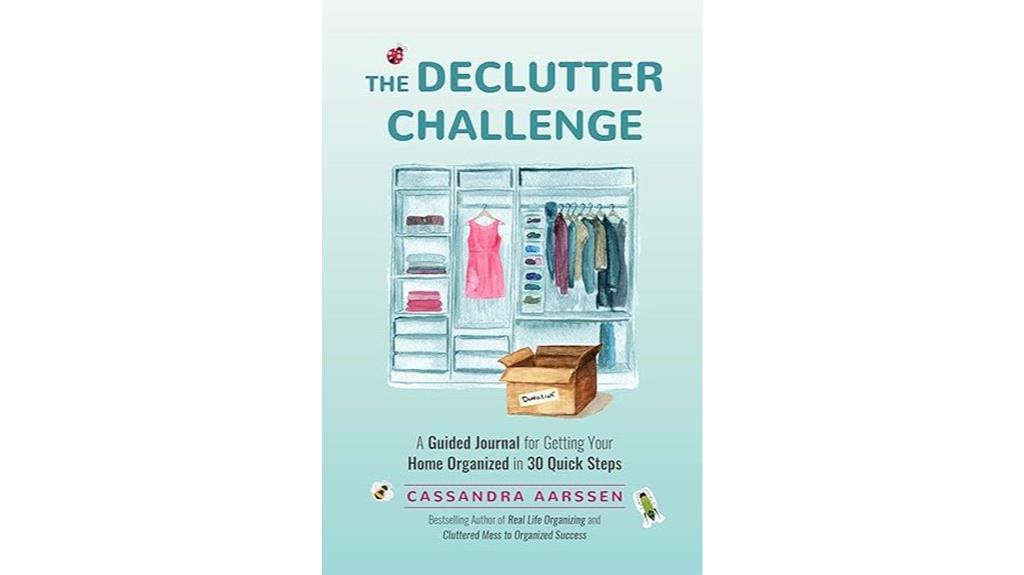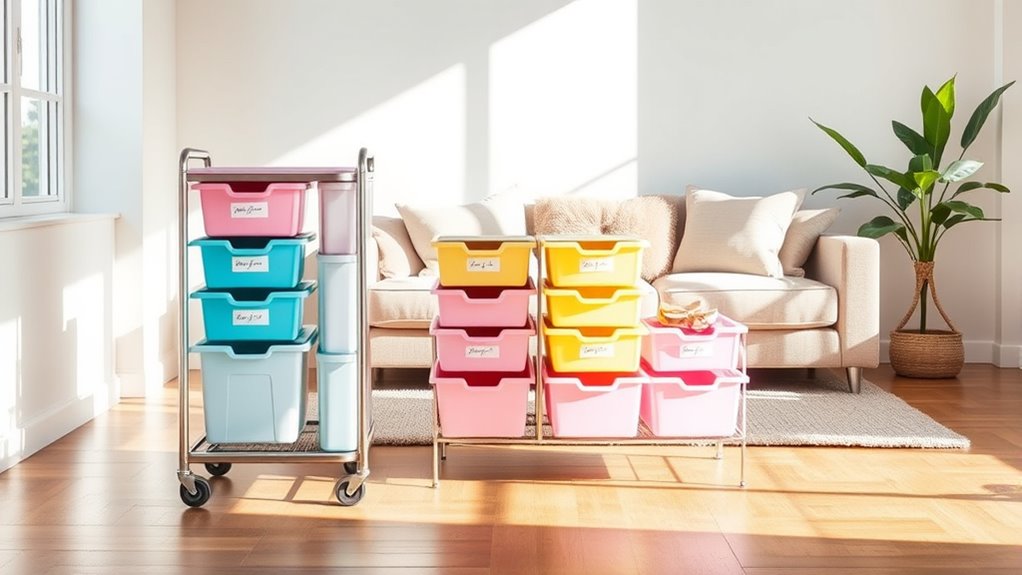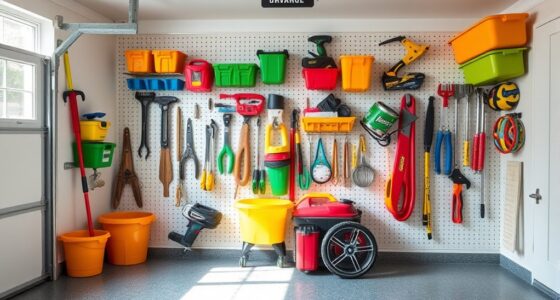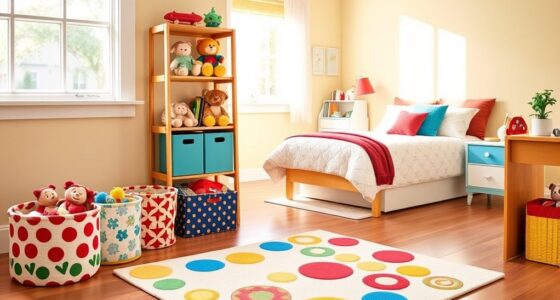I've found that the ultimate decluttering tool can truly spark joy in your home by simplifying the organization process. It encourages me to make mindful decisions about my belongings, helping me release attachments to unnecessary items. This tool offers practical steps and community support, making it easier to tackle clutter. Plus, the aesthetic appeal motivates me to maintain a beautiful, organized space. If you want to know how to make the most of this tool, there's more to explore.
Key Takeaways
- The Ultimate Decluttering Tool simplifies the process by guiding users to identify items that no longer spark joy in their lives.
- It encourages mindful decision-making, helping individuals reflect on their psychological attachments to belongings for a more meaningful decluttering experience.
- This tool offers structured, step-by-step guidance tailored to individual needs, making it ideal for those feeling overwhelmed by clutter.
- Engaging with a community around decluttering provides support, inspiration, and shared success stories, enhancing the overall journey.
- Aesthetically pleasing organizers and matching personal styles promote motivation, making the decluttering process enjoyable and visually appealing.
The Declutter Challenge: A Guided Journal for Home Organization

If you've ever felt overwhelmed by clutter and don't know where to start, "The Declutter Challenge: A Guided Journal for Home Organization" is perfect for you. This journal helped me understand my attachment to items, revealing why I struggle with clutter. I appreciated the practical steps it offers, allowing me to personalize my organizing approach. As I documented my progress, I felt motivated by others' stories of triumph, even after setbacks like a house fire. The supportive community surrounding this challenge made me realize I'm not alone, turning a challenging task into an engaging journey towards a more organized home.
Best For: Individuals feeling overwhelmed by clutter who seek a personalized and supportive approach to home organization.
Pros:
- Provides practical, step-by-step guidance tailored to individual needs, making decluttering more accessible.
- Encourages self-reflection to understand psychological attachments to items, fostering long-term change.
- Builds a supportive community around the decluttering journey, helping users feel less isolated in their struggles.
Cons:
- May not fully address the specific challenges faced by individuals with chronic illnesses or disabilities.
- Some readers might find the process of journaling requires additional time and effort.
- The focus on personal reflection may not appeal to those seeking quick, straightforward cleaning methods.
Factors to Consider When Choosing The Decluttering Tools That'll Spark Joy in Your Home

When I think about decluttering, I realize that choosing the right tools is essential for making my space feel joyful. I consider factors like how well they fit my needs, their practicality, and even my emotional ties to items. Plus, I want to guarantee these tools are accessible and budget-friendly for everyone in my home.
Personalization for Your Needs
Personalization plays an essential role in selecting decluttering tools that truly resonate with your needs. I've learned that everyone faces unique clutter challenges shaped by their personal histories and emotional attachments. By engaging in guided journaling, like in "The Declutter Challenge," I reflect on my motivations, allowing me to create tailored strategies that fit my experiences. Instead of sticking to rigid methods, I customize my decluttering systems to match my household dynamics, which makes organization more sustainable. Understanding my decluttering triggers helps me choose tools that align with my emotional responses to clutter. Additionally, connecting with a community and sharing our journeys provides inspiration and insights into effective tools that may resonate with my situation, enhancing my personalized approach.
Practicality and Usability
Choosing decluttering tools that truly spark joy in your home hinges on their practicality and usability. I always look for tools that are easy to use, especially those that don't require excessive effort or complicated instructions. This is essential for anyone with chronic illnesses or disabilities. Multifunctional tools are a game-changer, as they simplify my space and reduce clutter by serving multiple purposes. I also prefer tools that are visually appealing and fit my decor; they motivate me to keep things organized. Size matters too; I make sure the storage capacity fits my needs without overcrowding. Finally, I appreciate tools that encourage engagement, like journals or checklists, making the decluttering process more interactive and enjoyable.
Emotional Connection to Items
Decluttering often goes beyond practicality; it taps into our emotional connections with items we've accumulated over time. I've found that these attachments often stem from personal histories or significant life events, making it challenging to let go. Understanding why I cling to certain items—like familial influences or sentimental memories—has helped me approach this process with compassion. By reflecting on the emotional weight of my belongings, I can better distinguish what truly sparks joy versus what's just taking up space. Guided journaling has been a game changer, revealing the psychological barriers I face. Recognizing that it's normal to struggle with these attachments helps me feel less isolated, creating a sense of community as I navigate my decluttering journey.
Accessibility for Everyone
While traversing the world of organizing tools, I've realized that accessibility is key for everyone involved. We need tools that cater to a diverse audience, especially those with chronic illnesses or disabilities. Customizable features allow us to adapt our organizing systems to fit our unique needs and abilities. Digital options, like PDFs or apps, offer alternative journaling methods for those who struggle with traditional paper tools. It's essential that these tools promote ease of use, providing clear instructions and practical guidance so we don't feel overwhelmed. Finally, community support can make a huge difference; sharing experiences helps us feel less isolated in our decluttering journey and encourages us to embrace the tools available to us.
Budget-Friendly Options
Finding budget-friendly options for decluttering can truly transform your home without breaking the bank. I love using repurposed containers like shoeboxes and jars, as they're not only cost-effective but also let me personalize my space. Thrift stores are treasure troves for baskets and organizational tools, often at a fraction of retail prices. Implementing a "one in, one out" rule helps me stay organized and encourages mindful purchases, avoiding the need for expensive storage solutions. I've also discovered local community groups and online marketplaces where people offer free or low-cost items while decluttering. Finally, DIY projects, like creating shelving from reclaimed wood, add a unique touch while maximizing my space economically. Embrace creativity—it's a game-changer!
Aesthetic Appeal Matters
After exploring budget-friendly options, it's clear that aesthetics play a significant role in the decluttering process. When I choose visually appealing organizers, I find myself more motivated to tackle the task at hand. Research shows that storage solutions that match my personal style not only keep things functional but also inspire me to maintain organization. Incorporating colors and designs I love instills a sense of pride in my space, making it easy to keep tidy. Additionally, a beautifully organized environment reduces stress and creates a calming atmosphere, which is essential when dealing with clutter's emotional weight. By selecting aesthetically pleasing decluttering tools, I transform organization from a chore into a rewarding experience, fostering a positive mindset toward maintaining order in my home.
Community Support Resources
Many people overlook the power of community support when tackling decluttering. Engaging with like-minded individuals can make a huge difference in your journey. I've found that joining decluttering groups or forums not only provides encouragement but also a sense of belonging. Sharing progress and challenges with others fosters collective motivation and accountability.
Online platforms often host virtual workshops or challenges that inspire action. Plus, local community centers frequently organize decluttering events where you can gain practical advice and emotional support. Social media groups dedicated to decluttering offer a readily accessible network of tips and success stories. Connecting with others facing similar struggles truly makes the process enjoyable and sparks joy in our homes. So don't hesitate to reach out—community support can be invaluable!
Frequently Asked Questions
How Long Does the Decluttering Process Typically Take?
The decluttering process can vary greatly depending on your space and how much stuff you've got. Personally, I find it takes anywhere from a few hours to a couple of weeks. I usually set aside a few hours each weekend to tackle different areas in my home. Breaking it down into manageable chunks keeps me motivated and prevents overwhelm. Just remember, it's not a race—take your time and enjoy the transformation!
Can I Declutter With Kids in the House?
Absolutely, you can declutter with kids in the house! I've found that involving them in the process can actually make it fun. We set a timer and turn it into a game, seeing who can find the most toys to donate. It's a great way to teach them about sharing and organization. Just be patient and make it a positive experience, and you'll be surprised at how much we can accomplish together!
What to Do With Items I No Longer Need?
Did you know that nearly 80% of the items we own are rarely used? When I find items I no longer need, I start by sorting them into categories: donate, sell, or recycle. I love donating to local charities because it helps others while clearing my space. Selling online's also a great option for earning a little cash. As for items that can't be reused, recycling feels like the responsible choice.
Are There Online Resources for Decluttering Inspiration?
Absolutely, I've found plenty of online resources that inspire me to declutter! Blogs and YouTube channels dedicated to organization offer practical tips and creative ideas. Pinterest is another great source; I often scroll through beautiful images that motivate me to tackle my own space. Social media groups also provide community support and shared experiences, which really help when I feel stuck. I definitely recommend exploring these platforms for a fresh perspective!
How Can I Maintain a Clutter-Free Home After Decluttering?
Picture a serene morning, sipping coffee while the sun streams through your window. To maintain a clutter-free home after decluttering, I set up daily habits. I designate a spot for everything, tackle one small area each week, and regularly reassess my belongings. I've learned to let go of items that no longer serve a purpose. By embracing this mindset, I keep my space organized and peaceful, making it easier to enjoy my surroundings.
Conclusion
As you commence your decluttering journey, remember that the right tools can truly transform your space and spark joy. Picture the satisfaction of a tidy home tailored just for you, where every item holds meaning. But wait—what if I told you there's a surprising twist to this journey? You're not just clearing clutter; you're uncovering hidden treasures and memories. So, what will you discover when you begin? The answer might just change everything.









